Sunshine in July
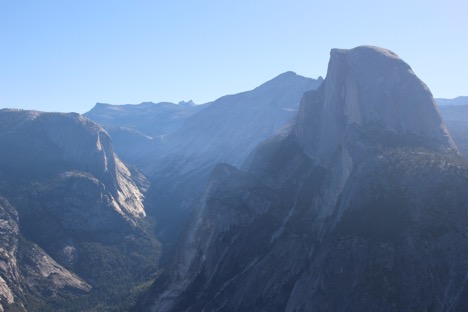
Photo Courtesy Aurora Perez
Newborn birds emerge
The sun hides behind the fog
Rays peek through the trees
June was a month full of adventure for our team. We
celebrated Eid—celebrated by Muslims worldwide that marks the end of Ramadan—at
Lands End with Bollywood dancing, samosas, and habitat restoration. We also
went to Yosemite National Park with our LINC (Linking Individuals to their
Natural Community) program for a week full of camping, hiking adventures, and
campfires!
Announcements
Want to become a long-term Steward at Lands End? Read on!
If you love being outside, are interested in
habitat restoration, and want to make a positive impact in your local national park, we encourage you to sign up
for our Lands Ends Volunteer Steward Program.
This volunteer opportunity provides
flexibility and is perfect for anyone looking to spend some quiet time and
relax in the company of the natural world at Lands End. Volunteers will be
trained and be a part of the greater National Park Service Volunteer-In-Parks (VIP)
Programs. For
more information and the application, please
click here.
Restoration and Volunteer Management
Internship
Park Stewardship Program - Golden Gate National Parks Conservancy
Are you excited about working in the outdoors and
learning about natural resources management? Are you interested in
engaging communities in the Golden Gate National Parks through volunteer
programs and land management projects?
Working in some of the Bay Area’s most dramatic and beautiful landscapes, home
to 36 rare and endangered plant and animal species, the Park Stewardship
Program engages and sustains vibrant communities in the conservation of park
lands. Established in 1993, the Park Stewardship Program is part of the Golden
Gate National Parks Conservancy, the non-profit support partner of the Golden
Gate National Parks.
Overview of Internship
We have internship positions with all three of Park Stewardship’s regional
teams- San Francisco, San Mateo and Marin. Through a one-year position on one
of these teams, you will be a field ecologist, environmental educator, and
community builder. As an intern, you will be introduced to many aspects of
habitat restoration and help maintain climate resilient ecosystems by managing
invasive plants, planting natives, and species monitoring. Throughout the year,
you will also participate in various elements of land stewardship which include
developing and running volunteer programs for youth, adults, school groups,
corporate groups, and community organizations. Interns also have the
opportunity to build a strong professional network, as well as benefit from
considerable formal and on-the-job training.
Most importantly, you will be an integral part of a diverse and fun Park
Stewardship team, and will obtain an in-depth understanding of the values of
the park system through shared experiences, workshops, and ongoing dialogue.
For more information, click
here
Events
For a complete list of upcoming events please visit the Presidio
Trust and Parks
Conservancy events homepages!
July 7, 8:45 AM – 3
PM: Alcatraz Gardens Class Series: Building Mosaics
Join us in the beautiful Alcatraz Gardens for this hands-on
workshop to build your own mosaic tile with instructor Kristi Halva.
Kristi has been involved with the arts since her days in high school and has
recently studied under the direction of Laurel True, a well-known mosaic artist
at the Institute of Mosaic Arts in Oakland California.
This
day-long course will begin with a tour of the historic gardens with Parks
Conservancy’s program manager Shelagh Fritz to gain inspiration for you to
create your own mosaic. With ideas in mind, Kristi will walk through the steps
of creating a beautiful piece of art of your own. Please dress for the
variable weather of the island—bring water, sunscreen, and a hat—also please
wear clothes you don't mind getting dirty.
Cost: $50, click here
to buy tickets. For more information, click here.
July 18, 2 – 4 PM: Mindfulness & Meditation in the Park
We invite you to join us for a quiet, peaceful, and
meditative walk through the forests in the Presidio. Let’s experience the
beauty and magic of nature in this part of the city, and find ways for calm and
balance within and around us.
We will explore simple ways to connect and reconnect with
nature through short mindful meditations and other interactive activities. No
prior experience is necessary, just an open mind!
To register for this
event, click here.
July 24, 4:30 - 6 PM: For Members: Sutro Baths Exploration
Park historian John Martini will lead a short but strenuous
exploration walk in, around, and through the ruins of Sutro Baths, once the
world’s largest indoor swimming complex. Find out how Adolph Sutro built his
great Baths, how they operated, who went there, and what recreation was like at
“The Cliff" 120 years ago. Registration for this event will open at 9 am
on June 24. Please return to this page to register at that time.
The event is free, but register here to receive special instructions to be in the park after-hours!
Click here for more information.
August 11, 9 – 11:30 PM: Mindfulness & Meditation in the Park
We invite you to join us for a quiet, peaceful, and
meditative walk through the forests in the Presidio. Let’s experience the
beauty and magic of nature in this part of the city, and find ways for calm and
balance within and around us.
We will explore simple ways to connect and reconnect with
nature through short mindful meditations and other interactive activities. No
prior experience is necessary, just an open mind!
To register for this event,
click here.
July Wildlife
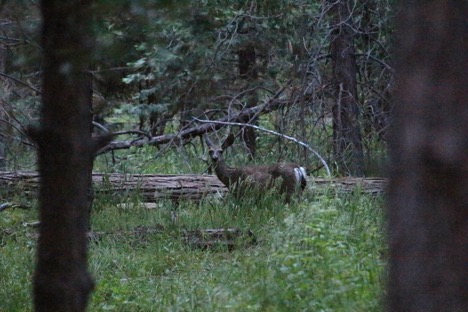
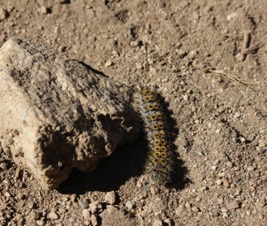 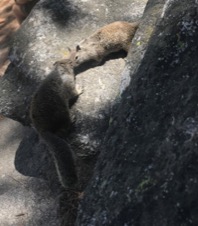
Yosemite Wildlife
Photos
Courtesy Vincent Nicolosi & Aurora Perez
The Quail Songs
By Vincent Nicolosi
Ecological Restoration and Volunteer Management Academic Intern
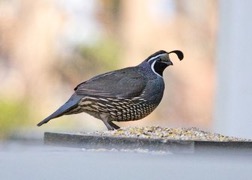
Photo from freeimages.com
|
Chic-ca-go! The familiar mating call that belongs to the female quail can be heard throughout California. Just over the Golden Gate Bridge in the Marin Headlands, the California quail can be seen in large groups—or coveys—foraging for seeds and leaves. But in San Francisco, you are more likely to see quail served on a dinner plate than in your local park.
Just over 100 years
ago, the California quail population was estimated to be well over a thousand.
By the late 1980s, the population had reduced to under 200, and by the new
millennium less than 50 remained. Today, there is only one quail known to be
living in the City.123
Whereas some birds
can move when they need to, the quail is a non-migratory bird that rarely
travels farther than 10 miles from its birth site. Lacking the ability to fly
great lengths, the quail is susceptible to land predators and habitat
destruction. These factors likely contributed to the dramatic decline of the
San Francisco population.123
Somewhat
ironic, the California quail was named the official state bird of San Francisco
in 2001- when the quail population was at an all-time low and on the brink of
local extinction. As a social bird who lives in large family groups, shares
nests and raises their young together, the quail seemed an apt pick for a city
that once was home to the Summer of Love. Unfortunately, the attention gained
from receiving such a title did little to save the San Francisco population.
Today, there is only one Quail left in San Francisco.123
The
quail population in California is very strong. They are not endangered or
threatened outside of San Francisco; in fact, despite being regularly hunted, the
population has increased in recent years. This raises a unique question: Is the
loss of a local population justified because it exists elsewhere in the wild?
The story of the quail in San
Francisco allows us to reflect on how humans interact with the plants and
animals that we cohabit the land with. We have the ability to ask ourselves,
what, if anything, should we do when we see the steady decline of a local
species? These aren’t easy questions, and their answers are equally
challenging; nevertheless, they are important to ask ourselves as individuals
who have so dramatically altered the land around us.
Quail Facts2
- The plume atop a quail’s head is actually 6 feathers.
- Quails often do not need to drink water, instead they obtain
liquid from insects and succulents.
- Oldest recorded California quail was 6 years and 11 months
old.
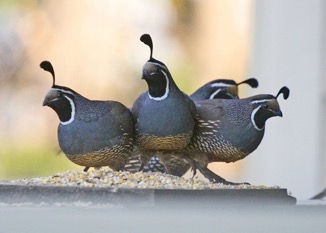
Photo from freeimages.com
|
Our Neighborhood Trees
By Aurora Perez
Ecological Restoration and Volunteer Management Intern
Summer time is the
perfect time to wander around the city and look up at all our flowering trees
of the season. With a busy city like San Francisco, it is sometimes easy to
forget how much green the city has to offer. Because of the driving wind, foggy
summers, and sandy soils, trees can have a hard time in San Francisco. San
Francisco’s urban forest is a relatively recent experience. To understand the
city and have a flashback image of what it looked like 200 years ago we can
look to Marin and our coastal lands, where we see grassy hills, sand dunes
habitat, and coastal scrub (for more information read the trees of San Francisco by Mike Sullivan, 2013).
San Francisco has
welcomed a unique mix of trees from around the world that thrive in our unique
conditions. These trees all provide many environmental, community, and personal
benefits:
- Trees can help soothe and relax us while connecting us to nature and our
surroundings.
- The color green relates to balance and harmony. From a color psychology
perspective, it is the great balancer of the heart and the emotions, creating
our wellbeing and equilibrium.
- Green is also the color of growth and is known to renew and restore
energy from the stresses of modern, fast-paced living.1
People often
respond to the presence of trees beyond simply observing their beauty. We feel
peaceful and tranquil in a grove of trees. Trees have been reported as having a
relaxing effect on students studying for exams and on easing a patient’s
recovery from an illness.2
My favorite study spot while I was in college was the UC Davis Arboretum
and Public Garden—it was my green sanctuary that is filled with majestic
redwoods and oak trees.
After reading The Trees
of San Francisco by Mark Sullivan, I was inspired by his suggested tree tours
around the city and decided to go on one of my own. I went for a walk around
the presidio and observed some of our flowering trees. I photographed a couple
of my favorites and had great time doing so. Before moving to the city, I
thought that San Francisco was just a hilly place, with tons of people and
buildings, but my perspective has completely changed since then. There are so
many beautiful trees and parks all around us for us to enjoy. I encourage
everyone to take a stroll around the neighborhood and look up at all our
wonderful trees.
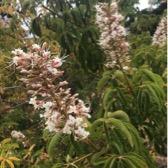 Photo Courtesy Aurora Perez Photo Courtesy Aurora Perez |
1. California Buckeye (Aesculus californica)
The California Buckeye grows to a height of 10 to 20 feet
and has a broad oval, deciduous spreading canopy. It has clusters of fragrant
white/pale rose flowers and a toxic fruit. All parts are actually toxic, unless
you’re a squirrel.
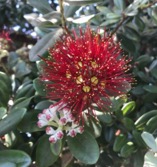 Photo Courtesy Aurora Perez Photo Courtesy Aurora Perez |
2. Pohutukawa (Metrosideros excelsa)
Pohutukawa
is native to New Zealand, where its often referred to as the Christmas tree.
The Pohutukawa is popular in cultivation and is commonly seen as a street or
lawn tree in San Francisco. It has vibrant red flowers made up of the male
fertlizing organ, the stamens.
 Photo Courtesy Aurora Perez Photo Courtesy Aurora Perez |
3. Wattle
(Acacia retinodes)
The Wattle tree is often also
classifed as a evergeen shrub. It is native to South Australia, Victoria and
Tasmania. It has perfect yellow flowers (meaning both male and female parts are
in each flower) that bloom all throughout the year.
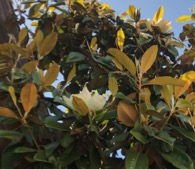 Photo Courtesy Aurora Perez Photo Courtesy Aurora Perez |
4.
Southern Magnolia (Magnolia grandiflora)
The southern
magnolia grows to a height of 80 feet. It has large, white, fragrant lotus-like
shaped flowers. I wasn’t tall enough to see the opened flowers, but I was still
able to catch a sniff of their beautiful scent.
Highlights from the Field
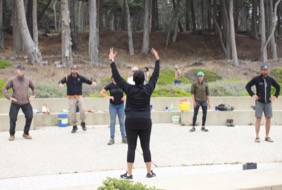 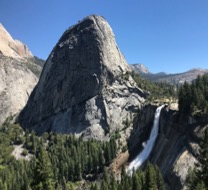
Photos
Courtesy Yakuta Poonawalla & Vincent Nicolosi
 
- Joined the Youth team and LINC
Program on a weeklong camping trip in Yosemite!
Drop-In Volunteer Programs
|
Volunteer on Thursdays:
Presidio Coastal Bluffs, 1–4 pm
July, 12
August 2
Lobos Creek: July 19
Cancellations: July 26
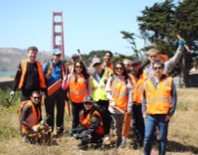

|
Volunteer on Saturdays:
Lands End, 1–4 pm
July 7, 14, 21
August 4
Cancellations: July 28

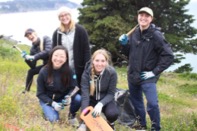
Photos Courtesy Aurora Perez,
Yakuta Poonawalla,
and Vincent
Nicolosi
|
|
Click here
to find our volunteer work day schedule.
See
you in the field!
|

|